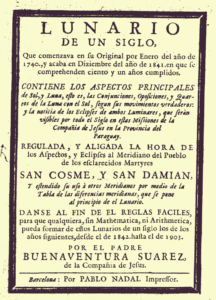In the vast history of science, some names stand out as particularly noteworthy, despite often remaining in the shadow of popular obscurity. One such name is that of the Jesuit astronomer and priest Buenaventura Suárez, whose scientific contributions left an indelible mark on the study of the heavens and the measurement of time.
Born on September 3, 1679 (some sources suggest July 14 of the same year) in present-day Argentina, Buenaventura Suárez entered the Society of Jesus at the age of 16. After completing his studies at the University of Córdoba, he joined the evangelizing mission of the Society in Paraguay (that is, the missions that comprise the Jesuit Route) where he combined his religious work with the fascinating exploration of the cosmos.
Pioneer of astronomy in the Southern Hemisphere
In addition to his missionary work, Buenaventura Suárez is also known for being the first astronomer in the southern hemisphere to make systematic observations of the celestial vault. Despite limited resources, he constructed his own observatory in the Paraguayan jungle using simple yet effective materials such as reeds, wood, and rock crystals.
With the help of Guaraní assistants, Suárez constructed rudimentary yet functional telescopes, which he used to conduct detailed observations of planetary movements, solar and lunar eclipses, and other celestial phenomena. His findings attracted the attention of European scientists, who recognized the significance of his contributions to the understanding of the universe. He engaged in correspondence with renowned scientists such as L’Isle and Koegler.
A scientific legacy

In addition to his astronomical research, Suárez was also an accomplished scientist and mathematician. He produced detailed maps of the region, made terrestrial and celestial globes, and developed accurate weather forecasts. His meticulous work culminated in the creation of a century-long Lunarium, which detailed (with astonishing accuracy) the movements of the sun and moon between 1740 and 1840.
His scientific legacy continues to be the subject of study and admiration today. Despite his death in 1750 at the age of 70, his contributions endure as a testament to the power of knowledge and human curiosity.
Buenaventura Suárez was more than a Jesuit priest. He was a visionary who challenged the limits of knowledge and explored the mysteries of the universe, from his outpost in the South American jungle. His life and work serve as a reminder of the capacity that all human beings have to overcome challenges and achieve remarkable feats when using the power of their minds and spirits.
The mission of San Cosme y San Damián, on the Jesuit Route of Paraguay, hosts a permanent exhibition on the work and discoveries of Buenaventura Suárez.





